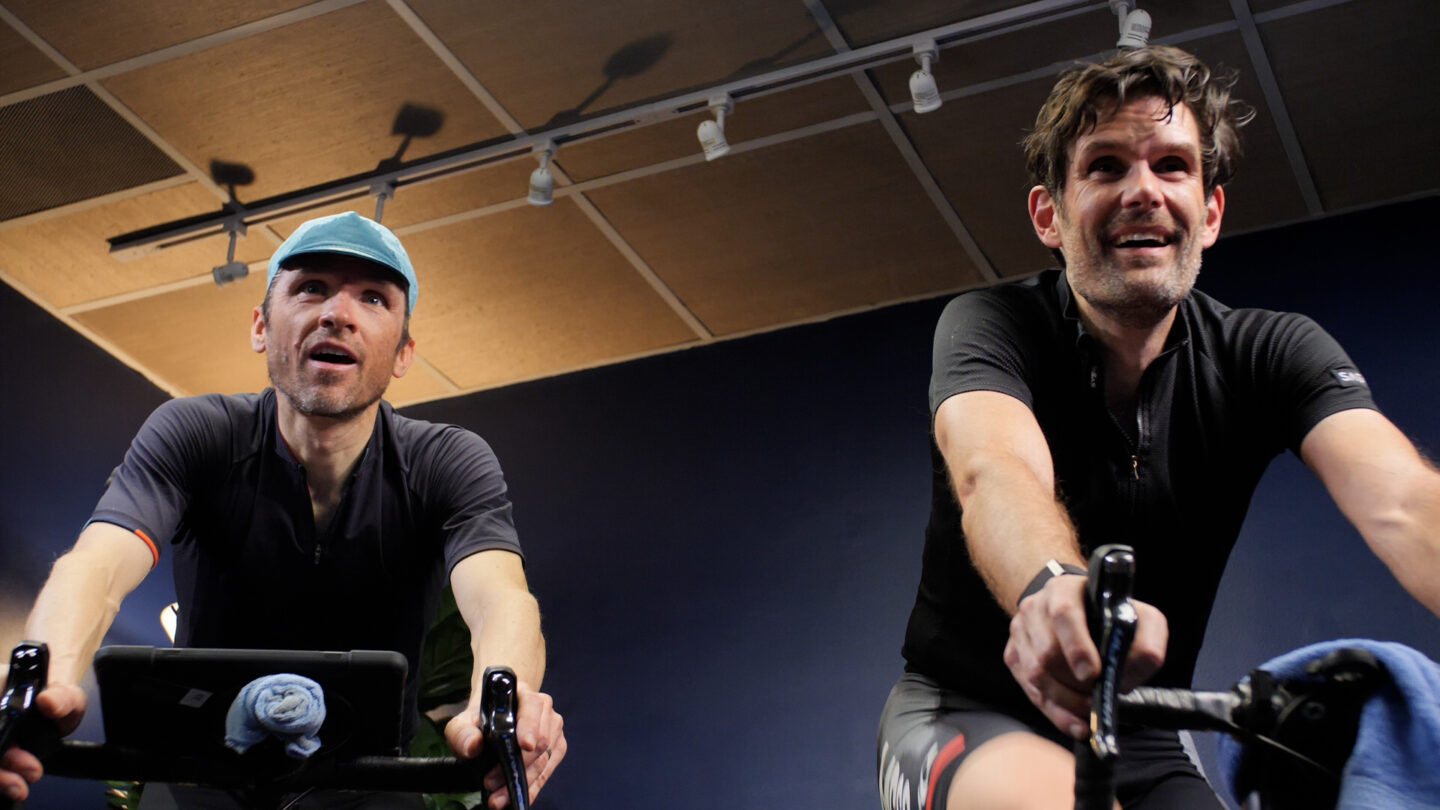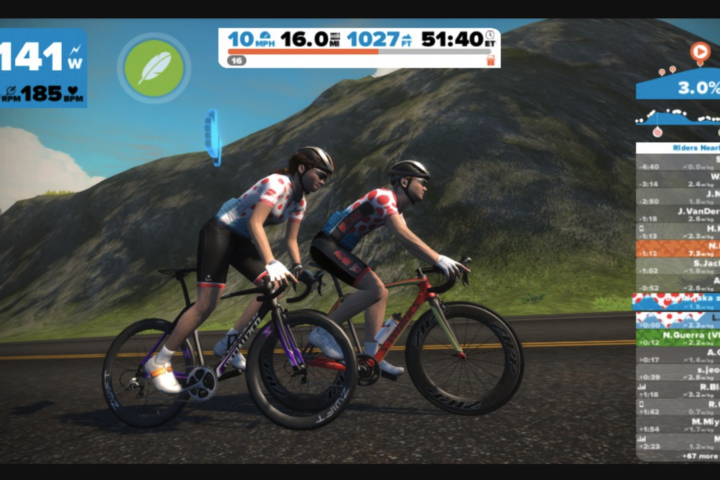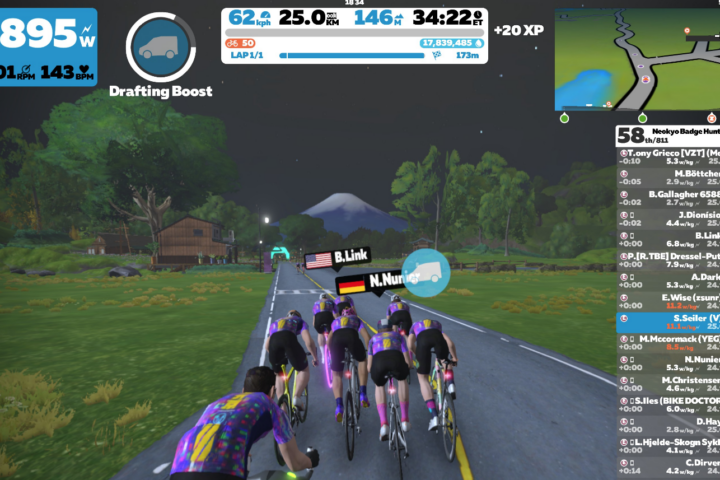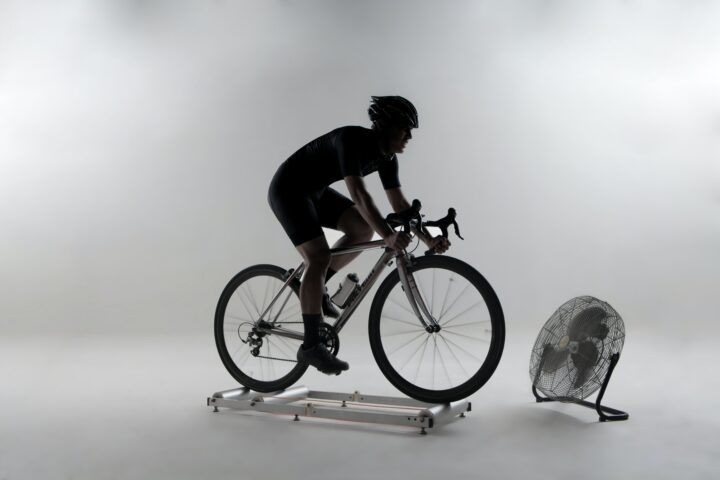When you’re sitting in the start pen of a Zwift race, one thing is certain: Each of your competitors is pedaling frantically in an effort to get a jump on the field.
The chaos that follows the start leaves every rider feeling as though they’re being left behind, creating a feedback loop that ensures everyone surges. There’s little reason not to; instead of handlebars tangling in the bunch, avatar deftly swerve around (or simply pass through) riders to ensure good positioning.
These efforts may leave you physically unscathed, but the ensuing breathlessness can have a lasting effect throughout the remainder of the race. This breathlessness is your body attempting to fill the gap between the energy it needs and the amount the aerobic system can supply. Whenever you’re paying out more than you’re taking in, you’re at a deficit, and this is oxygen deficit paid by your anaerobic system.
Much of this can be avoided, however, with an appropriate warm-up prior to the race. What is proper, however, depends on the demands of the event.
For the purpose of this article on Zwift racing, many potential benefits of a warm-up do not apply. For example, increased muscle temperature, contractility, and nerve conduction, as well as increased anaerobic metabolism, are primarily beneficial to exercise performances lasting less than two minutes.
The main benefit of a warmup for events lasting more than five minutes hinges on increased oxygen consumption, and thus aerobic energy production, at the onset of hard, race efforts.
The benefits of an active warm-up
By increasing aerobic energy production, your body can meet the demands of Zwift racing’s intense starts with less contribution from the anaerobic energy system. This reduced reliance on the anaerobic system increases the potential for its contribution at decisive moments later in the race. (See Figure 1.)
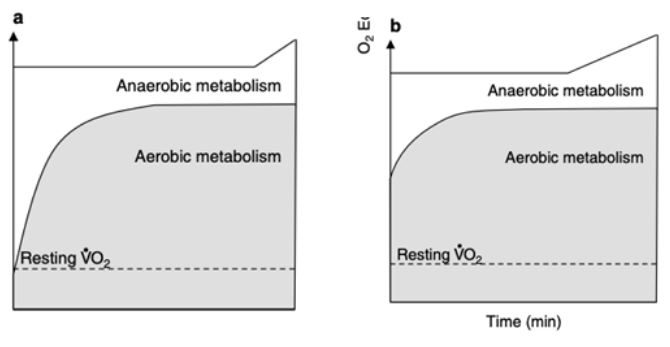
Because we can anticipate that the opening of your Zwift race will have a high energy requirement (in the severe intensity domain; see Figure 2), it is advantageous to complete a warm up that is based on workloads that significantly elevate your oxygen consumption. Knowing this, we can design a proper warm-up.
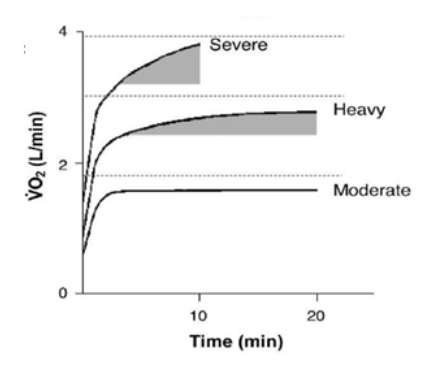
It is possible to warm up too easily. In the above graphs we can see that workloads at or below zone 1 (in a three-zone model) elicit a moderate, steady-state, oxygen utilization. A warm-up at this workload leaves additional aerobic energy production on the table.
Heavy domain workloads (with the upper bound being your anaerobic threshold), elicit a further increase in VO2; but despite the constant workload, an athlete will incur a non-steady state VO2 (slow-component), which is indicative of accumulating fatigue.
Further increases in workload, above threshold and into the severe domain, are characterized by an additional increase in oxygen consumption, but also drastically reduced time to exhaustion.
Because of this, it is easy to assume that warm-ups that elicit the highest pre-race oxygen consumption, those in the severe exercise domain, ought to lead to the best performances.
However, when looking at research, a common theme arises: Warm-ups that are too intense lead to multiple factors that decrease endurance performance. These factors include, but are not limited to, over-activation of the anaerobic system, acidosis, increased core temperature, compromised pacing strategies, and decreased carbohydrate availability.
A successful warm-up, one that improves your Zwift performance, is one that balances the benefits of increased baseline oxygen consumption and the detrimental effects of increased core temperature, acidosis, and depleted fuel stores.
To achieve this balance, riders ought to rely mainly on workloads below their aerobic threshold. Additionally, an effort up to anaerobic threshold is useful to further drive oxygen utilization. Because a steady state of oxygen consumption will be achieved within four minutes, efforts up to the anaerobic threshold ought to be limited to this timeframe.
Additionally, athletes can drive their VO2 slightly higher with short stints above their anaerobic threshold. These severe intensity efforts, however, need to be brief and include short rest periods to limit fatiguing consequences.
An example warm-up
While each rider is likely to benefit from an individualized warm-up plan based on fitness level and psychological factors, an example warm-up routine with explanations is included below.
In this protocol, a rider will either join the Zwift race early and complete the entire warm-up while in the holding area, or they will complete it on an alternative course and transfer to the race during the three-minute recovery period at the end of the warm-up.
| Time to race start (min.) | Interval begins (min.) | Interval ends (min.) | Interval length (min.) | Workload (% of threshold) | Purpose |
|---|---|---|---|---|---|
| 21 | 0 | 8 | 8 | 65% | Achieve steady state of moderate oxygen consumption |
| 13 | 8 | 12 | 4 | 90% | Achieve steady state of high oxygen consumption |
| 9 | 12 | 14 | 2 | 55% | Active recovery: pay back minimally incurred debt, reduce rate of core-temp increase |
| 7 | 14 | 15 | 1 | 105% | Short, severe-domain surge—further increase VO2 while minimizing detrimental effects |
| 6 | 15 | 17 | 2 | 55% | Active recovery |
| 4 | 17 | 18 | 1 | 105% | Short, severe-domain surge |
| 3 | 18 | 21 | 3 | 55% | Active recovery of less than five mins. to ensure elevated VO2 at start |
| 0 | race start | – | – | – |
The key benefits of warming up
The warm-up is an integral part of race prep. It’s even more important for races that start fast, as so many Zwift races do. The benefits of an appropriate warm-up for these fast-start events include increasing baseline oxygen consumption, thereby decreasing oxygen deficit and the anaerobic contribution. If done correctly, you’ll also avoid the detrimental effects of increased core temperature, decreased carbohydrate availability, and increased acidosis.
The ideal scenario? The intensity should be limited to moderate efforts with and short heavy domain efforts to prevent fatigue. The duration should be limited to 15-20 minutes to prevent core temperature rise and carbohydrate depletion. Finally, the recovery following the warm-up should remain less than five minutes to prevent a return to baseline VO2.
References
Bishop, D., Bonetti, D., Dawson, B. (2001) The effect of three different warm up intensities on kayak ergometer performance. J. Sports Sci. 33(6) 1026-1032.
Bishop, D. (2003) Warm Up I: Potential Mechanisms and the effects of passive warm up on exercise performance. Sports Med, 33(6) 439-454.
Bishop, D. (2003) Warm Up II: Performance changes following active warm-up and how to structure the warm-up. Sports Med, 33(7) 483-498.
Bishop, D., Maxwell, NS. (2007) Effects of active warm up on thermoregulation and intermittent sprint performance in hot conditions. J. Sci. Med. In Sport, 2009; 12, 196-204.
Brouns, F., Rehrer, NJ., Menheere, PP. (1989) Effect of Carbohydrate intake during Warming-up on the Regulation of Blood Glucose During Exercise. Int.J Sports Med.
Burnley, M., Doust, JH., Jones, AM. (2005) Effects of prior warm-up regime on severe intensity cycling performance, Med Sci. Sports Exerc, 37(5) 838-845.
Gutin, B., et al. (1973) Oxygen consumption in the first stages of strenuous work as a function of prior exercise. Nat. Conv. for Health, PE, and Rec.
Levels, K., Teunissen, L., Haan, A., de Koning, J., van Os, B., Daanen, H. (2013) Effect of warm up and pre-cooling no pacing during a 15km cycling time trial in the heat. Int. J. Sports Phys. and Perf. 8, 307-311.
Mcintyre, J., Kilding, A. (2014) Effects of high-intensity intermitted priming on physiology and cycling performance. J. of Sports. Sci. 33:6, 561-567
Poole, D., Jones, A. (2012) Oxygen Uptake Kinetics. Comprehensive Physiology, 2(2) 933-996.
Ren, J., Brober,S., Sahlin,L. (1989) Oxygen deficit is not affected by the rate of transition from rest to submaximal exercise. Chemsitry, Medicine.
Swanwick, E., Matthews, M. (2018)The Effects of pre-exercise blood glucose on responses to short duration high intensity exercise. Int. J. Sports and Exercise Med, 4(1)

